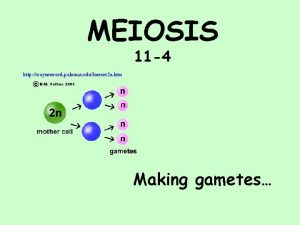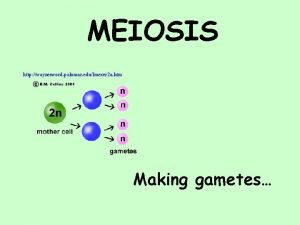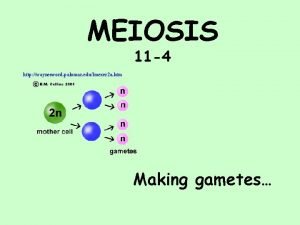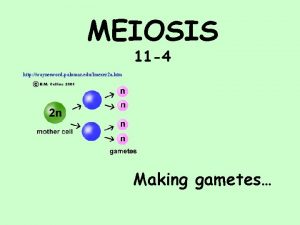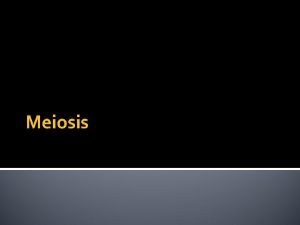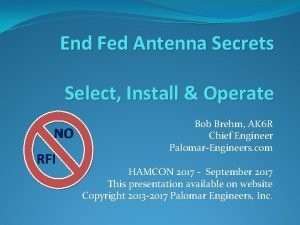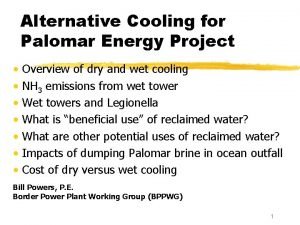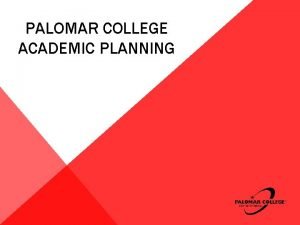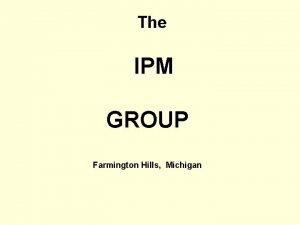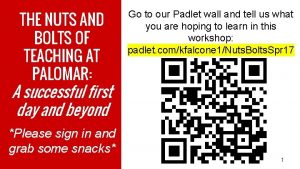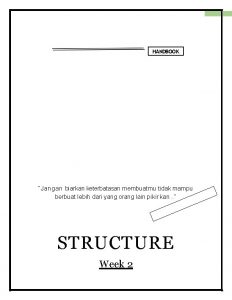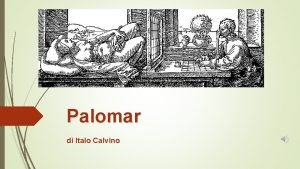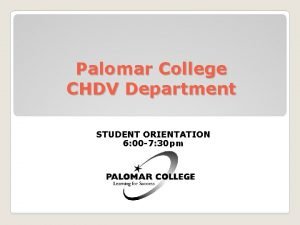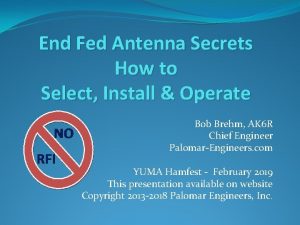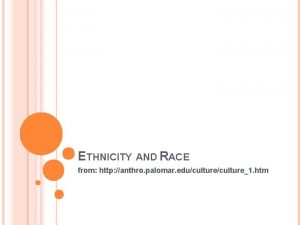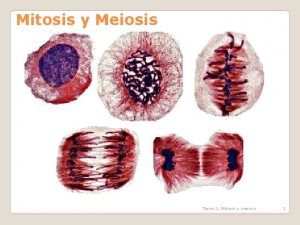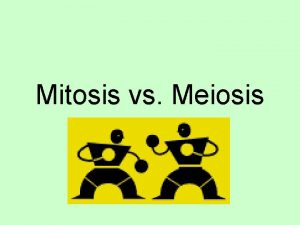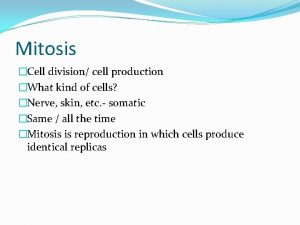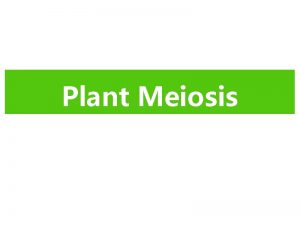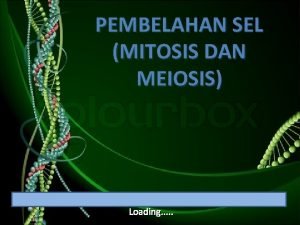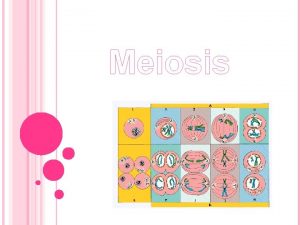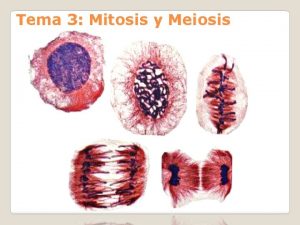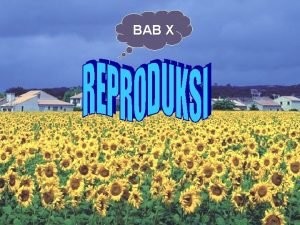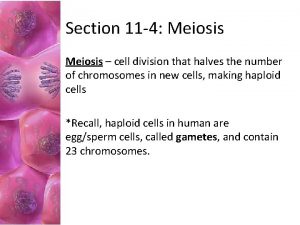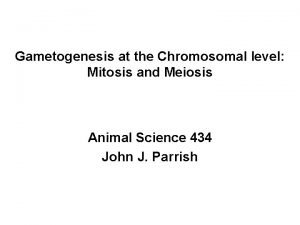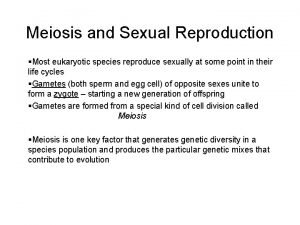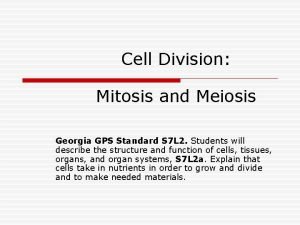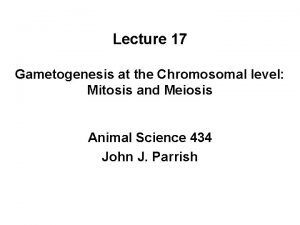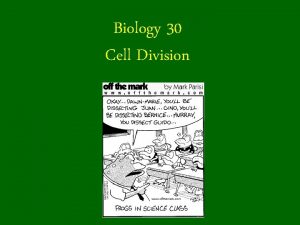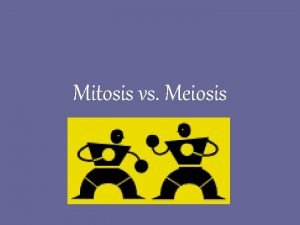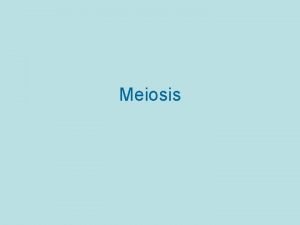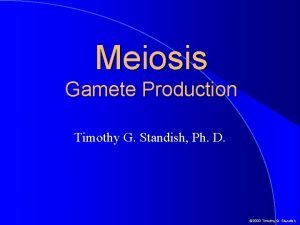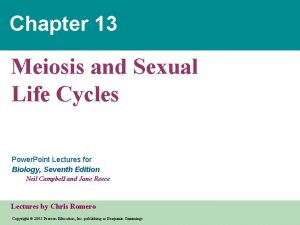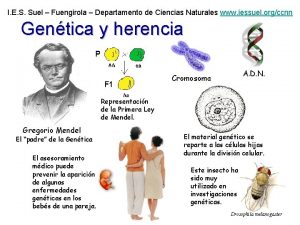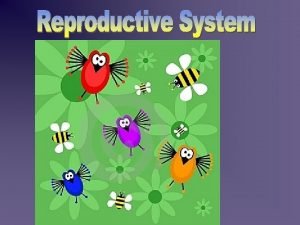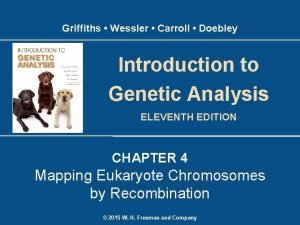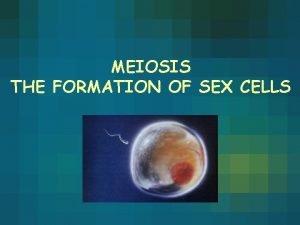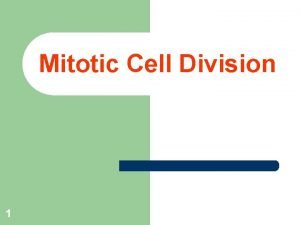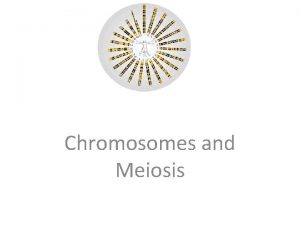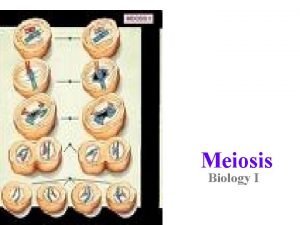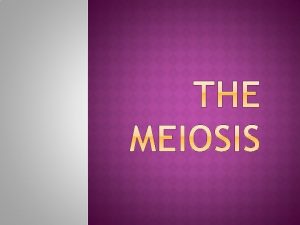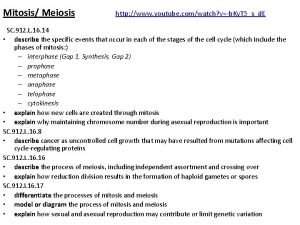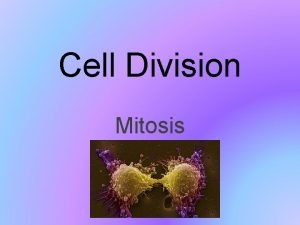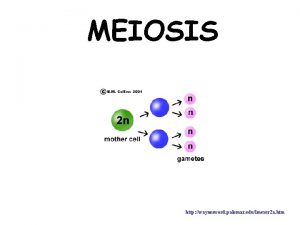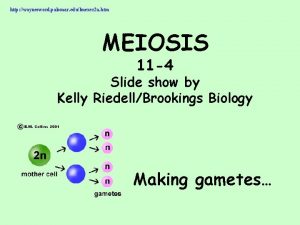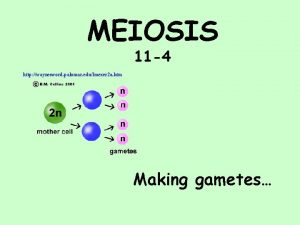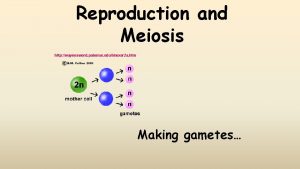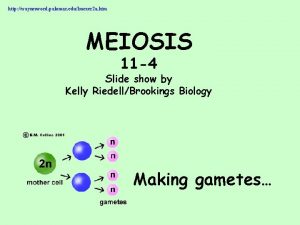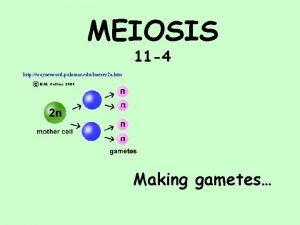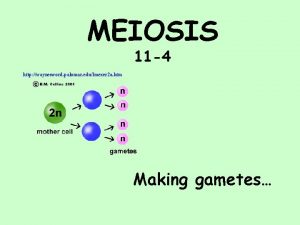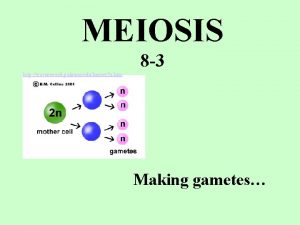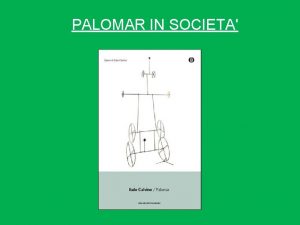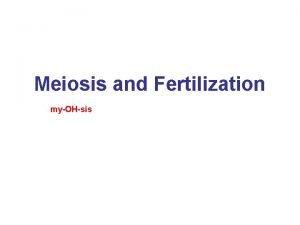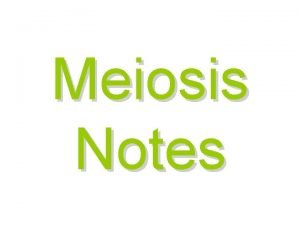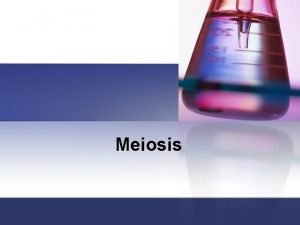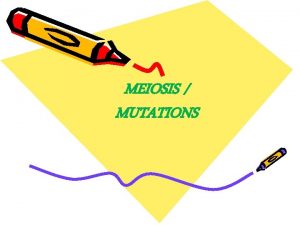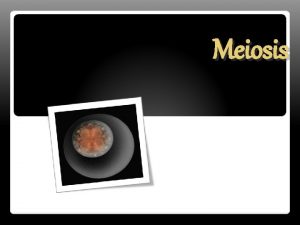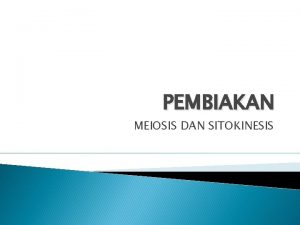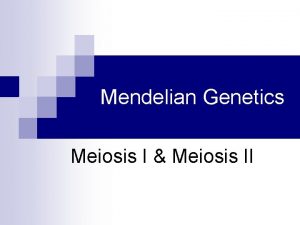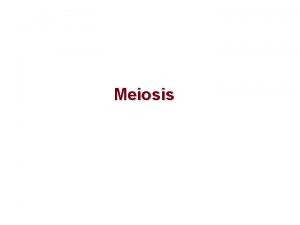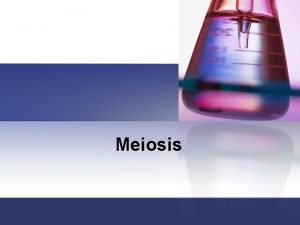MEIOSIS 11 4 http waynesword palomar edulmexer 2





























































- Slides: 61

MEIOSIS 11 -4 http: //waynesword. palomar. edu/lmexer 2 a. htm Making gametes…

Interest Grabber 1. How many chromosomes would a sperm or an egg contain if either one resulted from the process of mitosis? 46 chromosomes 2. If a sperm containing 46 chromosomes fused with an egg containing 46 chromosomes, how many chromosomes would the resulting fertilized egg contain? Do you think this would create any problems in the developing embryo? 46 + 46 = 92; a developing embryo would not survive if it contained 92 chromosomes. 3. In order to produce a fertilized egg with the appropriate number of chromosomes (46), how many chromosomes should each sperm and egg have? Sperm and egg should each have 23 chromosomes.

Remember from Chapter 1: CHARACTERISTICS OF LIVING THINGS REPRODUCE ALL LIVING THINGS _____ Planaria animation: http: //www. t 3. rim. or. jp/~hylas/planaria/title. htm Family http: //babyhearing. org/Parenet 2 Parent/index. asp

ASEXUAL REPRODUCTION Bacteria reproduce using http: //www. emc. maricopa. edu/faculty/farabee/BIOBK/Bio. Bookmito. html BINARY FISSION _________________ http: //fig. cox. miami. edu/~cmallery/150/mitosis/c 7. 13. 2. hydra. jpg Budding & regeneration are used by plants and animals to reproduce asexually (mitosis) Planaria animation: http: //www. t 3. rim. or. jp/~hylas/planaria/title. htm

BINARY FISSION & MITOSIS identical Produces cells that are _____ copies of parent cell

ADVANTAGES OF ASEXUAL REPRODUCTION Can make offspring faster Don’t need a partner http: //www. mrgrow. com/images/cutting. jpg

DISVANTAGES OF ASEXUAL REPRODUCTION ALL ALIKE Species CAN’T change and adapt One disease can wipe out whole population http: //www. mrgrow. com/images/cutting. jpg

SEXUAL REPRODUCTION Family image from: http: //babyhearing. org/Parenet 2 Parent/index. asp Combines genetic material from 2 parents (sperm & egg) so offspring are DIFFERENT genetically _____ from parents

ADVANTAGES OF SEXUAL REPRODUCTION Allows for variation in population Individuals can be different Provides foundation for EVOLUTION Allow species adapt to changes in their environment http: //naturalsciences. sdsu. edu/classes/lab 8/spindex. html

Image by Riedell EGG Image by Riedell + http: //www. angelbabygifts. com/ SPERM If egg and sperm had same number of chromosomes as other body cells. . . baby would have too many chromosomes! http: //www. acmecompany. com/stock_thumbnails/13217. forty-six_chromosomes. jpg

MEIOSIS is the way… http: //waynesword. palomar. edu/lmexer 2 a. htm to make cells with ½ the number of chromosomes for sexual reproduction

Video 1 Meiosis Overview Click the image to play the video segment 11 A.

DIPLOID & HAPLOID Most cells have 2 copies of each chromosome DIPLOID 2 n = _______ (one from mom; one from dad) HOMOLOGOUS CHROMOSOMES = SOMATIC All BODY (______) cells are diploid

DIPLOID & HAPLOID Some cells have only one copy of each HAPLOID 1 n chromosome = _______ All sperm and egg cells are haploid

MITOSIS • Makes ___ 2 cells genetically identical _____ to parent cell & to each other 2 n • Makes ___ cells • Makes _____ SOMATIC (body) • Used by organisms to: increase size of organism, repair injuries, replace worn out cells http: //waynesword. palomar. edu/lmexer 2 a. htm

MEIOSIS 4 cells • Makes ____ genetically different from parent cell & from each other 1 n cells • Makes __________ Germ cells OR Gametes (sperm & eggs) • Used for ______ sexual reproduction http: //waynesword. palomar. edu/lmexer 2 a. htm

WHAT MAKES MEIOSIS DIFFERENT ? 1. SYNAPSIS & CROSSING OVER (PROPHASE I) 2. SEGREGATION & INDEPENDENT ASSORTMENT (ANAPHASE I) 3. Skip INTERPHASE II (NO S) CELL DIVIDES TWICE, BUT… ONLY COPIES DNA ONCE

WHAT MAKES MEIOSIS DIFFERENT ? 1. Homologous chromosomes pair up during ________ PROPHASE I SYNAPSIS = _______ This group of FOUR (4) chromatids is called a TETRAD _________ Images modified from: http: //www. emc. maricopa. edu/faculty/farabee/BIOBK/Crossover. gif

WHAT MAKES MEIOSIS DIFFERENT? 1. Exchange of DNA between OVER homologous pairs = CROSSING _______ during PROPHASE I Allows shuffling of genetic material http: //www. emc. maricopa. edu/faculty/farabee/BIOBK/Crossover. gif

Video 5 Crossing Over SEE CROSSING OVER ANIMATION Click the image to play the video segment. 11 E

HOMOLOGOUS CHROMOSOMES Image modified by Riedell • SAME SIZE • SAME SHAPE • CARRY GENES for the SAME TRAITS IDENTICAL • BUT NOT _______! (Don’t have to have the SAME CHOICES) http: //sps. k 12. ar. us/massengale/genetics%20 tutorial. htm

Image modified by Riedell CROSSING OVER rearranging of DNA • Allows for_________ in different combinations • After crossing over, chromatid arms NOT IDENTICAL anymore are________ http: //sps. k 12. ar. us/massengale/genetics%20 tutorial. htm

WHAT MAKES MEIOSIS DIFFERENT ? 2. Separation during ANAPHASE I SEGREGATION & INDEPENDENT ASSORTMENT Separates gene choices and allows shuffling of genetic material

Video 4 Segregation of Chromosomes Click the image to play the video segment 11 D.

SEGREGATION (Anaphase I)

SEGREGATION & CROSSING OVER together make even more combinations See an animation http: //waynesword. palomar. edu/lmexer 2 a. htm

INDEPENDENT ASSORTMENT http: //fig. cox. miami. edu/~cmallery/150/mitosis/c 13 x 9 independent-assortment. jpg

INDEPENDENT ASSORTMENT at ANAPHASE I Lots of different combinations are possible! This is why you don’t look exactly like your brothers and sisters even though you share the same parents!

http: //www. tokyo-med. ac. jp/genet/anm/mimov. gi

WHAT MAKES MEIOSIS DIFFERENT ? Crossing over Segregation Independent assortment are ALL ways MEIOSIS results in =_______________ GENETIC RECOMBINATION different So daughter cells are _______ from parents and from each other

WHAT MAKES MEIOSIS DIFFERENT ? 3. Skip INTERPHASE II (No S) CELL DIVIDES TWICE, BUT … ONLY COPIES ITS DNA ONCE MITOSIS: G 1 S G 2 P MEIOSIS: G 1 S M G 2 P M P M A T C (I) C ( II ) A T

Video 2 Animal Cell Meiosis, Part 1 & Part 2 Click the image to play the video segment 11 B. & C Video 2

Figure 11 -15 Meiosis Section 11 -4 Meiosis I Go to Section:

Figure 11 -15 Meiosis Section 11 -4 Meiosis I Go to Section:

Figure 11 -15 Meiosis Section 11 -4 Meiosis I Go to Section:

Figure 11 -15 Meiosis Section 11 -4 Meiosis I Go to Section:

Figure 11 -15 Meiosis Section 11 -4 Meiosis I Go to Section:

Figure 11 -17 Meiosis II Section 11 -4 Meiosis II Prophase II Metaphase II Anaphase II Meiosis I results in two The chromosomes line up in a The sister chromatids haploid (N) daughter cells, similar way to the metaphase separate and move toward each with half the number of stage of mitosis. opposite ends of the cell. chromosomes as the original. Go to Section: Telophase II Meiosis II results in four haploid (N) daughter cells.

Figure 11 -17 Meiosis II Section 11 -4 Meiosis II Prophase II Metaphase II Anaphase II Meiosis I results in two The chromosomes line up in a The sister chromatids haploid (N) daughter cells, similar way to the metaphase separate and move toward each with half the number of stage of mitosis. opposite ends of the cell. chromosomes as the original. Go to Section: Telophase II Meiosis II results in four haploid (N) daughter cells.

Figure 11 -17 Meiosis II Section 11 -4 Meiosis II Prophase II Metaphase II Anaphase II Meiosis I results in two The chromosomes line up in a The sister chromatids haploid (N) daughter cells, similar way to the metaphase separate and move toward each with half the number of stage of mitosis. opposite ends of the cell. chromosomes as the original. Go to Section: Telophase II Meiosis II results in four haploid (N) daughter cells.

Figure 11 -17 Meiosis II Section 11 -4 Meiosis II Prophase II Metaphase II Anaphase II Meiosis I results in two The chromosomes line up in a The sister chromatids haploid (N) daughter cells, similar way to the metaphase separate and move toward each with half the number of stage of mitosis. opposite ends of the cell. chromosomes as the original. Go to Section: Telophase II Meiosis II results in four haploid (N) daughter cells.

Figure 11 -17 Meiosis II Section 11 -4 Meiosis II Prophase II Metaphase II Anaphase II Meiosis I results in two The chromosomes line up in a The sister chromatids haploid (N) daughter cells, similar way to the metaphase separate and move toward each with half the number of stage of mitosis. opposite ends of the cell. chromosomes as the original. Go to Section: Telophase II Meiosis II results in four haploid (N) daughter cells.

MITOSIS vs MEIOSIS INTERPHASE I http: //www. pbs. org/wgbh/nova/baby/divi_flash. html • DNA is spread out as chromatin • Nuclear membrane/ nucleolus visible • DNA is copied during S phase • Makes stuff new cell needs in G 2 SAME AS MITOSIS

MITOSIS vs MEIOSIS PROPHASE I http: //www. pbs. org/wgbh/nova/baby/divi_flash. html DNA scrunches into chromosomes Nuclear membrane/ nucleolus disappear Centrioles/ spindle fibers appear DNA scrunches into chromosomes Nuclear membrane/ nucleolus disappear Centrioles/spindle fibers appear Homologous pairs match up

MITOSIS vs MEIOSIS METAPHASE http: //www. pbs. org/wgbh/nova/baby/divi_flash. html • Chromosomes line up in middle METAPHASE I Chromosomes line up in middle with homologous partner

MITOSIS vs MEIOSIS ANAPHASE I http: //www. pbs. org/wgbh/nova/baby/divi_flash. html APART: Chromatids split APART: Chromatids stay together Homologous pairs split

MITOSIS vs MEIOSIS TELOPHASE I http: //www. pbs. org/wgbh/nova/baby/divi_flash. html See TWO nuclei Nuclear membrane/ SAME AS MITOSIS nucleolus return DNA spreads out as chromatin Spindle/centrioles disappear

MITOSIS vs MEIOSIS CYTOKINESIS I http: //www. pbs. org/wgbh/nova/baby/divi_flash. html Cytoplasm splits into 2 cells SAME AS MITOSIS

MITOSIS vs MEIOSIS INTERPHASE II http: //www. pbs. org/wgbh/nova/baby/divi_flash. html • DNA is spread out as chromatin SKIP • Nuclear membrane/ INTERPHASE II nucleolus visible • DNA is copied during S phase DNA NOT COPIED

MITOSIS vs MEIOSIS PROPHASE II http: //www. pbs. org/wgbh/nova/baby/divi_flash. html • DNA scrunches into chromosomes • Nuclear membrane/ nucleolus disappear • Centrioles/ spindle fibers appear SAME AS MITOSIS

MITOSIS vs MEIOSIS METAPHASE II http: //www. pbs. org/wgbh/nova/baby/divi_flash. html • Chromosomes line up in middle SAME AS MITOSIS

MITOSIS vs MEIOSIS ANAPHASE II http: //www. pbs. org/wgbh/nova/baby/divi_flash. html Chromatids split and move apart SAME AS MITOSIS

MITOSIS vs MEIOSIS TELOPHASE II http: //www. pbs. org/wgbh/nova/baby/divi_flash. html Two nuclei Nuclear membrane/ nucleolus returns Centrioles/spindle fibers disappear DNA spreads out as chromatin SAME AS MITOSIS

MITOSIS vs MEIOSIS CYTOKINESIS II http: //www. pbs. org/wgbh/nova/baby/divi_flash. html Cytoplasm splits http: //www. pbs. org/wgbh/nova/baby/divi_flash. html SAME AS MITOSIS

Ways Meiosis is different? • Homologous pairs match up & trade DNA (SYNAPSIS & CROSSING OVER) in PROPHASE I • SEGREGATION & INDEPENDENT ASSORTMENT in Anaphase I create genetic recombination • Skipping INTERPHASE II(Dividing TWICE but copying DNA once) produces 1 n cells

MAKING SPERM & EGGS

SPERMATOGENESIS __________= MAKING MATURE SPERM Mature & grow flagella

Sperm provides DNA All the starting nutrients, organelles, molecule building blocks, etc. have to come from the egg.

OOGENESIS _________ = MAKING a MATURE EGG Produces: 1 “good” egg 3 POLAR BODIES CYTOPLASM DIVIDES UNEVENLY

POLAR BODIES DEGENERATE (DIE) “Self digest” Using LYSOSOMES ________ = _________ APOPTOSIS “cell suicide” for good of organism

PWR PT BY K. RIEDELL • ADAPTED FOR MISSISSIPPI STATE BENCHMARKS
 Waynesword
Waynesword Waynesword
Waynesword Meiosis va mitosis
Meiosis va mitosis Waynesword
Waynesword Anaphase in meiosis vs mitosis
Anaphase in meiosis vs mitosis Study guide chapter 10 section 1 meiosis
Study guide chapter 10 section 1 meiosis Chromosomes number is maintained mitosis or meiosis
Chromosomes number is maintained mitosis or meiosis Chapter 10 meiosis 1 and meiosis 2
Chapter 10 meiosis 1 and meiosis 2 Meiosis and genetic variation usatestprep
Meiosis and genetic variation usatestprep Meosis prophase 2
Meosis prophase 2 Chromosome disability
Chromosome disability Http://www.cellsalive.com/meiosis.htm
Http://www.cellsalive.com/meiosis.htm Meiosis animation
Meiosis animation Palomar engineers loop antenna
Palomar engineers loop antenna Palomar power plant
Palomar power plant Daphne palomar shakespeare
Daphne palomar shakespeare Palomar college
Palomar college Palomar laser farmington
Palomar laser farmington Who you gonna call
Who you gonna call Jawaban toefl exercise (skill 6-8)
Jawaban toefl exercise (skill 6-8) Il mondo guarda il mondo palomar
Il mondo guarda il mondo palomar Palomar college child development center
Palomar college child development center End fed antenna
End fed antenna Anthro palomar
Anthro palomar Http //mbs.meb.gov.tr/ http //www.alantercihleri.com
Http //mbs.meb.gov.tr/ http //www.alantercihleri.com Siat.ung.ac.id
Siat.ung.ac.id Meiosis
Meiosis Phases of mitosis in order
Phases of mitosis in order Meiosis
Meiosis Gregor mendel data
Gregor mendel data Chromosome/mitosis/meiosis review answer key
Chromosome/mitosis/meiosis review answer key Where does meiosis occur in the body
Where does meiosis occur in the body Genetic vs physical map
Genetic vs physical map Pembelahan sel secara mitosis dan meiosis
Pembelahan sel secara mitosis dan meiosis Diploteno
Diploteno Objetivo de la mitosis y meiosis
Objetivo de la mitosis y meiosis Binary fision
Binary fision Meiosis worksheet
Meiosis worksheet Meiosis
Meiosis Section 11-4 meiosis
Section 11-4 meiosis Meiosis stages
Meiosis stages Meiosis diagram
Meiosis diagram Synapsis in meiosis
Synapsis in meiosis Real meiosis
Real meiosis Diagram of meiosis
Diagram of meiosis 4 daughter cells
4 daughter cells Crossover
Crossover Mitosis jeopardy
Mitosis jeopardy Difference between metaphase 1 and metaphase 2
Difference between metaphase 1 and metaphase 2 Cleavage
Cleavage Human development cycle
Human development cycle Ies suel actividades interactivas
Ies suel actividades interactivas Where in the female reproductive system does meiosis occur
Where in the female reproductive system does meiosis occur Chiasmata
Chiasmata Purpose of mitosis
Purpose of mitosis What is the purpose of mitosis
What is the purpose of mitosis Meiosis
Meiosis Meiosis 1
Meiosis 1 Why is meiosis referred to as reductional division
Why is meiosis referred to as reductional division Independent assortment meiosis
Independent assortment meiosis Stages of prophase in meiosis
Stages of prophase in meiosis Ipmat mitosis
Ipmat mitosis
